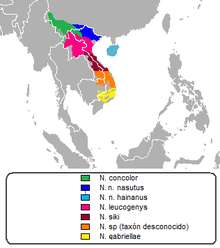Nomascus
| Nomascus[1][2] | |
|---|---|

| |
| Northern white-cheeked gibbon Nomascus leucogenys | |
| Scientific classification | |
| Kingdom: | Animalia |
| Phylum: | Chordata |
| Class: | Mammalia |
| Order: | Primates |
| Suborder: | Haplorhini |
| Infraorder: | Simiiformes |
| Family: | Hylobatidae |
| Genus: | Nomascus Miller, 1933 |
| Species | |
|
Nomascus concolor | |

| |
| Range map of Nomascus species | |
Nomascus is the second-most speciose genus of gibbons (family Hylobatidae). Originally, this genus was a subgenus of Hylobates, and all individuals were considered one species, Hylobates concolor. Species within Nomascus are characterized by 52 chromosomes. Some species are all black, some are light with a distinct black tuft of crown fur, and some have distinct, light-colored cheek patches. Nomascus is found from southern China (Yunnan) to southern Vietnam, and also on Hainan Island. One species, Nomascus nasutus, has been deemed "the most critically endangered ape species in the world".[2] All species in this genus are either endangered or critically endangered.
Classification[]
- Family Hylobatidae: gibbons[1]
- Genus Hylobates
- Genus Hoolock
- Genus Symphalangus
- Genus Nomascus
- Black crested gibbon, Nomascus concolor
- Tonkin black crested gibbon, Nomascus concolor concolor
- Laotian black crested gibbon, Nomascus concolor lu
- Central Yunnan black crested gibbon, Nomascus concolor jingdongensis
- West Yunnan black crested gibbon, Nomascus concolor furvogaster
- Eastern black crested gibbon, Nomascus nasutus
- Hainan black crested gibbon, Nomascus hainanus[3]
- Northern white-cheeked gibbon, Nomascus leucogenys
- Southern white-cheeked gibbon, Nomascus siki
- Yellow-cheeked gibbon, Nomascus gabriellae
- Northern buffed-cheeked gibbon, Nomascus annamensis[4]
- Black crested gibbon, Nomascus concolor
References[]
- ^ a b Groves, C. P. (2005). Wilson, D. E.; Reeder, D. M. (eds.). Mammal Species of the World: A Taxonomic and Geographic Reference (3rd ed.). Baltimore: Johns Hopkins University Press. pp. 180–181. ISBN 0-801-88221-4. OCLC 62265494.
- ^ a b Geissmann, Thomas (December 1995). "Gibbon systematics and species identification" (PDF). International Zoo News. 42: 467–501. Retrieved 2008-08-15.
- ^ Thomas Geissmann (April 2007). "Status reassessment of the gibbons: Results of the Asian Primate Red List Workshop 2006". Gibbon Journal (3).
- ^ Van Ngoc Thinh; Alan R. Mootnick; Vu Ngoc Thanh; Tilo Nadler; Christian Roos (2010). "A new species of crested gibbon, from the central Annamite mountain range". Vietnamese Journal of Primatology. 1 (4): 1–12.
External links[]
| Wikispecies has information related to Nomascus. |
| Wikimedia Commons has media related to Nomascus. |
- Nomascus
- Gibbons
- Mammals of Southeast Asia
- Primate genera
- Taxa named by Gerrit Smith Miller



